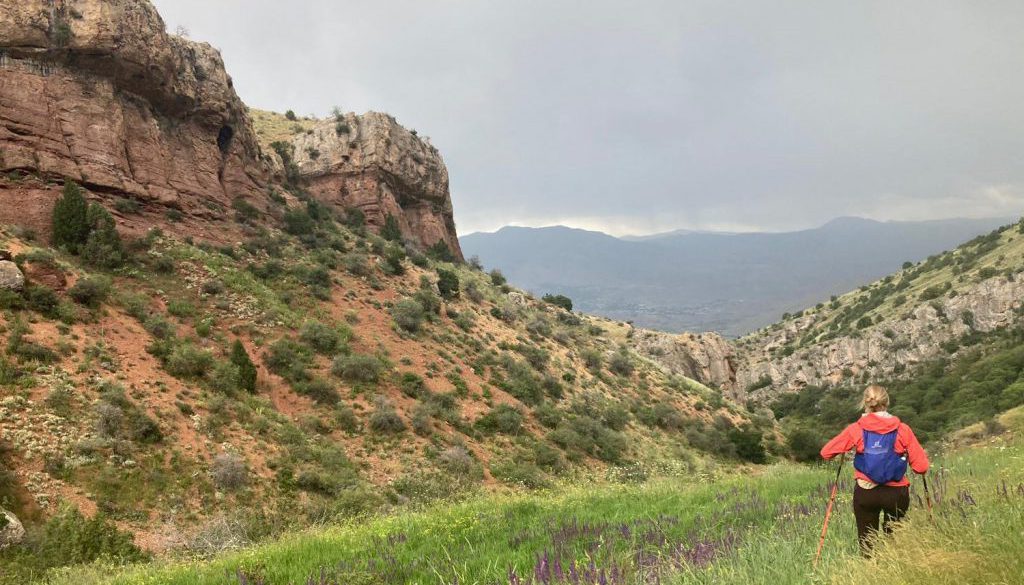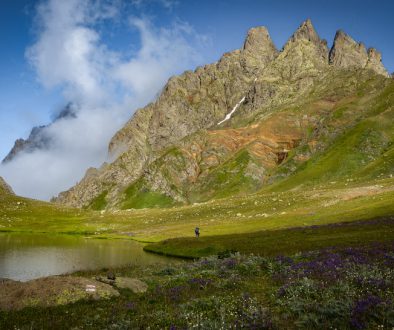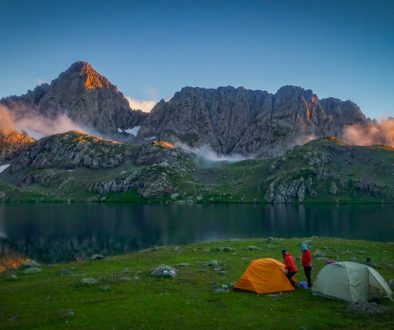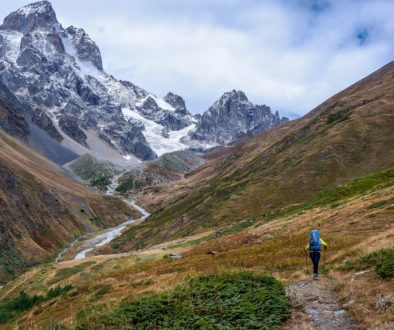Running the TCT Armenia, Part 1
Katya, ultrarunner living in the UK, spent 21 days and 8 hours this past June running the TCT Armenia in pursuit of the Fastest Known Time (FKT) on the trail. Spoiler alert: she did it! We caught up with her (literally!) on the trail, as our own executive director, Meagan, joined her for four days in the Gegham Mountains. Katya gave us some insights on how her journey was going so far, which we shared in our June newsletter. After she completed her run, Katya had a lot more to say about the trail, including preparations for such an undertaking, her favorite TCT section, running conditions, and why you should head to Armenia soon. If you’re considering hiking or running the TCT, keep reading Part 1 below, and stay tuned for Part 2 later this week to learn more about challenges on the trail, safety concerns, and an upcoming documentary of her experience!
Dreams, Preparations, and Support
What drew you to run this trail in particular, as opposed to other long-distance trails?
I spent the last two years of high school studying in Armenia, around the same time that the TCT was starting to be built. In the years that followed, I got into trail and ultra running, all the while following the development of the TCT. Seeing all the cool things people in the trail running community were doing, I had a thought in the back of my head for a couple years that it would be fun to try and run it one day — and as much as I tried to push it back, that thought never really left. Eventually I reached out to my good friend Lucia, who I’d studied with in Armenia and is now a documentary filmmaker, and her excitement for the project made us take the steps towards making it a reality. For me, returning to Armenia to try and run the TCT was about so much more than the physical challenge; it was a chance to come back almost 10 years later to get to see the country with new eyes and discover how I had changed, as well.

How did you prepare for this amazing, grueling adventure?
What I love about running — especially ultra distances — is that you often discover you have more in you than you think. I love the feeling of pushing just a little bit more every time, building the confidence to take on new adventures and challenges, both on the trail and in life. With that in mind, my preparation started a long time before the concrete project took shape. I pushed myself with some challenging races in the last few years, such as the UltraTrail Snowdonia 100k in 2023, which helped me get more comfortable in the mountains and build the confidence that allowed me to believe that I was capable of completing the TCT.
From the time we decided to do this, it took two years to actually make it happen. We spent months writing grant applications and reaching out to everyone we knew who might have some wisdom to share. This included, of course, Tom Allen, founder of the TCT. He encouraged us to join the TCT Trailblazers community, which was instrumental to our understanding of the trail and how to prepare.
Because we were relying on grants to cover the majority of project costs, everything fell into place only a couple months before we were due to set off. In retrospect, I wish we had listened to the advice we heard at the Royal Geographical Society Explore weekend in London last year, which was to buy flight tickets as soon as you are set on the idea, and the rest will sort itself out later! But since we hadn’t, April and May involved a lot of scrambling, making sure everything was ready. Around that time, my partner, Jonas, stepped in to take most of the logistics load off — he spent hours creating GPX files, printing maps, and figuring out how the crew would get from A to B to support me as best as they could.
On the physical training front, the last few years of hobby training for ultras provided me with a good base, and I more or less stuck with my usual training for an ultra — nothing super crazy. However, living in a pretty flat part of London, I tried to get out to more hilly areas a few times this spring to remind my legs what it was like to use those muscles. In April, I did a simulation run in England’s Lake District of Day 1 of the TCT (43km with 2700m of elevation) to test nutrition and gear and to reassure myself I was in shape to get through that long remote section. In the end, that simulation run was a walk in the park compared to the reality of the TCT…but it did help calm some of my nerves in the lead up.
In the end, the mental preparation was toughest — I had no idea what to expect or how I would cope with unexpected challenges. In the months leading up to our trip, I would wake up in the middle of the night in a panic about snakes or bears and question why I was doing this. That anxiety didn’t dissipate until I was faced with, and dealt with, a really challenging first couple days on the trail. Then, I started to trust myself more and adjust to the lack of control.
What role did your crew play in your experience?
This project 1000% couldn’t have happened without the crew. As much as I was solo for most of the trail, I couldn’t have done it the way we did without the crew providing physical and mental support. The crew was composed of Jonas for the duration of the project, with my good friend Maë joining for the first ten days, and my sister Lisa supporting us for the last week.
Jonas took on the mammoth task of all of the logistics preparation and management on the ground. He made sure that all my devices were charged, I always had the day’s GPX file on my watch, and I left with bottles of electrolytes. He monitored the inReach tracker and knew where the closest medical centres were at every point on the trail. He carried an immense mental load — like figuring out where to find antibiotics for me in the middle of nowhere — on top of the physical demands of driving the car (a modest Kia more meant for city roads) through tricky road conditions from checkpoint to checkpoint.
Maë crewed me for my first 100k last year, and it was such a blessing to have her here this time. She joined me for a couple sections, bushwhacking through the forest after Tandzaver, stumbling across a viper in the grass, and braving a sea of hogweed on the path — we both have the scars to prove it. On Day 2, I was in so much pain because of my bruised toenails that she hiked 10km out to meet me with bigger shoes and helped me get through the last part of that day with positivity, even as we climbed up through a massive thunderstorm.
The last week, Lisa brought a store of new energy, joining us in Dilijan when we were all exhausted. She supported not only me, but Jonas as well, who needed it just as much as I did at that point. She also helped to coordinate a homestay in a particularly remote section of the trail between Dilijan and Alaverdi where I was met on the trail by the team in a 4×4 driven by a 17 year old with impressive skills on those mountain tracks.
And then there were all the people who weren’t part of the on-the-ground ‘crew’ but who got us through. First and foremost Lucia, who had planned this adventure with me from the start but couldn’t be there herself, our friends David and Paula from Camino Ultra in London, who received (too many) horrific photos of my toe blisters and were always ready with seasoned advice, and everyone else who offered daily words of encouragement, like my parents and people following along on Instagram.

Trail Conditions
What were the running (vs. hiking) conditions like? If someone wanted to run a section of the TCT, which would you recommend?
I very quickly got a reality check about how much running I would be able to do on the TCT. In retrospect, maybe that was a blessing, since being forced to slog through some sections meant that I saved energy to get through the whole thing. A mix of really bad blisters acquired in the first few days, technical and overgrown trail conditions, and the fear of running through some areas with snakes or other animals, especially sheepdogs, meant that a lot of my TCT “run” was speed-hiking.
However, there were some stunning sections that I would recommend for running and would love to go back and do again: 1) the section between Artavan/Old Martiros and Gnishik is stunning, with seas of tall grass and rolling hills, and 2) Sevan-Gosh and Gosh-Dilijan, which have well-marked jeep tracks and trails through beautiful forest — super fun to run through.
Last time we spoke, you were still on the trail and mentioned that it was “rough around the edges”. Can you elaborate on that? What trail conditions should people expect to encounter?
Trail conditions are so variable on the TCT, from areas with almost no trail and intense bushwhacking, like in Arevik National Park, to well-marked paths around Dilijan, and everything in between. It also depends when in the season you go; we were warned that starting in June would mean some particularly overgrown sections but more water sources, while those hiking the TCT in August or September might benefit from less vegetation and paths cleared by previous hikers but come across fewer streams.
The terrain changes so much throughout the country, with parts of the trail going through tall grass, forest, desert rock, snowfields, and of course, the occasional stream. For off-trail sections — and even some sections that do have a path — you have to be a little creative with how you get from point to point. For me, the Geghams were the best example of this. We couldn’t go across many of the melting snowfields that still covered large parts of the landscape, so we had to do a lot of detours, scanning for safe routes and hoping our predictions were accurate. I do think that spotting the path and knowing where to put your feet gets a lot easier the longer you are on the trail — sometimes there was a track just a few meters to the side in fields of high grass that I didn’t notice. A lot of the TCT is made up of jeep tracks, and the sight of two lines cutting through the landscape after some off-trail sections was such a relief!
Weather is of course another important factor. With a lot of the trail in the mountains, the weather can change quickly, and hikers should be comfortable making decisions about when it is safe to proceed and when to seek shelter. Fog was a big challenge for me in the north, with super low visibility at times and very cold, wet conditions. As much as it’s important to be prepared for high temperatures and limited water on some sections of the trail, it is equally important to make sure you have warm, waterproof clothes for the Gegham Mountains and some of the mountains close to Hartashen. Hikers should also be prepared for long periods of wet feet — not just because of stream crossings, which you could often get around ok, but because of hiking through wet grass or particularly muddy, waterlogged sections.
What was the best section of the TCT?
Such a hard question! I know the last time we spoke I had just finished the Geghams section and I was in total awe of that experience. I still maintain it was one of the best sections of the TCT, not least because I had Meagan’s company. Our shared fear of thunderstorms and love of chocolate meant we were a great team. The Geghams had a brutal, stunning beauty — lots of rocky, snow-covered open landscape, and my favourite part was in the middle with big chunks of Obsidian in the mountain wall and along the path.
Other favourite sections included the section right before Gnishik because of the beautiful grassy landscape, and the trail from Sevan to Gosh, where I finally got some good running in and felt an amazing sense of freedom, moving quickly through the landscape. In spite of it being the section that broke me the most, or perhaps because of it, I also have some love reserved for Arevik National Park. Walking, running, and at times crawling through that beautiful but harsh landscape are some of my most vivid memories from the TCT.


Advice for Future TCT Hikers and Runners
What advice would you give to someone thinking about hiking (or running!) the TCT?
Take the jump and commit to doing it! I looked at all the people who had thru-hiked in the last couple seasons, and thought I wouldn’t be able to find similar strength and bravery, but you learn a lot as you go.
As part of this project, we established a supported Fastest Known Time of 21 days and 8 hours on the trail. We’re excited to see who breaks it and hope that it inspires others to get out there. There are definitely things we learned along the way that we would be happy to share — such as perhaps starting later in the season, when there is less bushwhacking and fewer snowfields in the Geghams, which would allow for more daily distance to be covered. We would be super happy to speak to anyone who is thinking of doing this to share insights on gear, training, and logistics.
That being said, another piece of advice is be ready to change your plans, be flexible, and don’t take any unnecessary risks. The last was a rule that we agreed to from the start and maintained throughout — another piece of advice we got from the RGS Explore weekend last year was “leave alive, leave as friends, finish the adventure” — and that prioritisation informed our decision making. Be prepared for bushwhacking to really slow you down — and if you are running with no tent, as I was, make sure you are aware of your nearest bailout points if you can’t go as far as planned on a given day.
Beyond that — enjoy! The varied beauty of the TCT is like nothing else I’ve ever seen, and the feeling you get crossing those landscapes with your own two feet is something really incredible. So whether you are planning to take it slow or do it fast — make sure you take some time to look up from your feet and enjoy what is around you.
And that’s a wrap for Part 1 of Katya’s adventure. Keep an eye out for Part 2, coming later this week for tips on safety, sheepdogs, weather, and information on the upcoming documentary about her journey!






